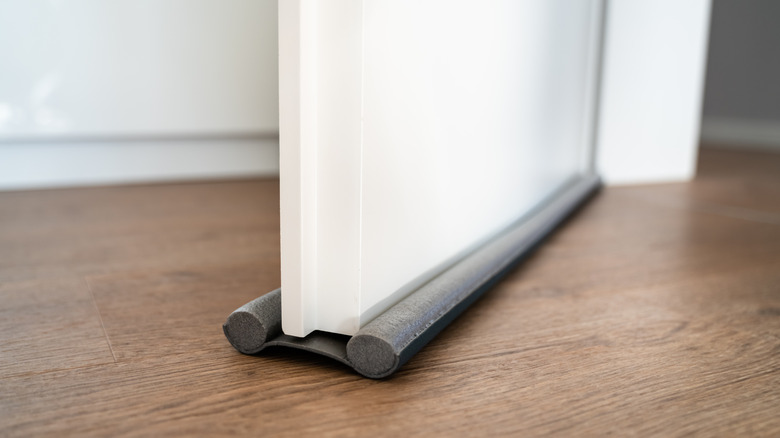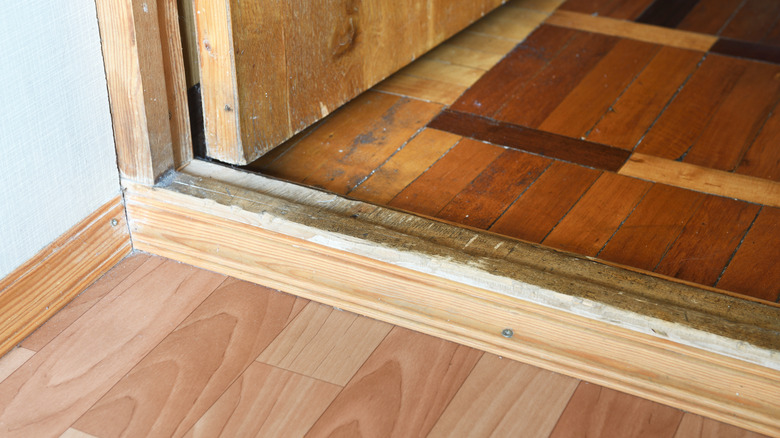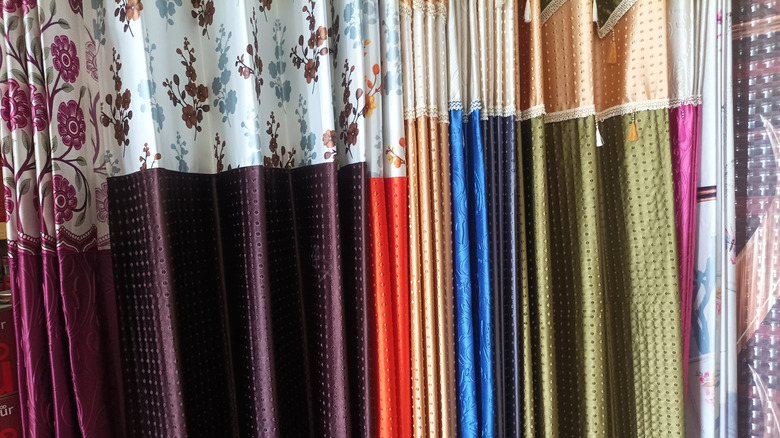Simple Methods For Insulating Your Interior Doors
We may receive a commission on purchases made from links.
Are you are among the 4.7 million Americans working from home at least part-time? If so, you may want to know the best way to soundproof a door inside — especially if you have video calls. A high door gap also allows light and sound to come in and disturb sound sleepers. Poor insulation can be costly in terms of comfort and finances. You may be dealing with interior drafts, which are common in pocket doors. If you're tired of unpredictable or high energy bills, insulating your interior doors is a worthy investment.
There are several simple ways to insulate existing interior doors. Doing so is cheaper than installing new ones, as average interior door replacement costs can range from $350 to $1200 — you can pay as much as $2,500 for a complex pocket door. If your doors aren't functioning as they should, some simple insulation tools, such as the Vellure Door Draft Stopper or TAROSE Silicone Seal Strip, cost less than $10 on Amazon.
From gap foam to weatherstripping to a curtains, the best method to make your interior doors more energy-efficient depends on the door material, opening mechanism, and even your preferred aesthetic. Before you begin the process, examine your door to find where any cracks or gaps are and ensure that you aren't wasting time insulating a door that's too damaged and may need replacement instead. With some light prep and a few dollars, you can quickly insulate an interior door for more comfort.
Door sweep or snake
Does your door have a large gap that allows too much light, sound, or dust to get inside? If so, a fast way to block it is with a door snake —named for how the tubular material wraps around the base of the door. Consider the highly rated MAGZO Door Draft Stopper. It's available in four colors, has lengths from 32 to 72 inches, and is weighed down with polyester wadding and glass beads.
Of course, you can also test your DIY skills by making your own. After measuring the door base and seams, cut your fabric to fit the bottom of your door. Fold the fabric in half, stitch the long side and one short end, and stuff it with cotton or other scraps. Stitch up the other side and wrap it around the bottom of your door.
A similar solution is a door sweep that attaches to the bottom of your door. Choose from ones made of plastic, fabric, rubber, or broom-like bristles that block exterior elements. Bristle ones, such as the highly-rated Deco Home Door Seal, are easy to install after sawing a piece to fit and screwing it on the bottom edge. Under-door sweeps like the Holikme Door Draft Stopper consist of soft foam and are easily attached with a hook-and-loop strip. If it gets dirty, simply remove it for a good washing and reattach it.
Weatherstripping
If you have seasonal weather, preparing for the winter cold may involve weatherstripping your exterior doors and windows. You can also use this method for your interior door insulation. Place this material along all of the edges of your door to prevent air leaks and other vulnerabilities. Weatherstripping may consist of vinyl or metal strips, adhesive foam, tape or rubber gaskets between the door and door jam. TAROSE Silicone Seal Strip — a best-selling item for less than $7 — comes in four colors and six lengths and works on your thresholds, closet doors, shower doors, and windows.
Before buying your weatherstripping, properly measure your door area so you have enough material to apply complete coverage. You want the strips to stick well, so clean the door with a rag and some alcohol and dry it off. Use one strip on each side that sits tightly at the corners of the door. It should press tightly between the door and the door jamb while allowing it to open and close with ease. Play it safe by cutting the strips a little longer than the door. Trim as needed to avoid gaps. After you've covered the appropriate areas, open and close the door to ensure the weatherstripping doesn't catch on anything. Some people may reinforce the weatherstripping with staples or tacks. For extra coverage, you may need to use weatherstripping in congress with another insulation material, such as a door sweep.
Gap foam
Made from honeycomb cardboard enclosed by fiberboard or veneer wood, hollow core doors are a lightweight option for home interiors. While they are easy to install and customizable, these doors have terrible soundproofing and resistance to temperature change, Luckily, you can easily insulate or fix a hole in a hollow core door with a few easy steps starting with buying spray foam. For insulation, drill holes a foot apart on the sides, top, and bottom. Insert the spray nozzle in the bottom holes so the foam can expand upwards within the frame. Continue spraying until it comes out the side and top holes — use something like a tube to push the foam deeper into the door. Once the door appears full, you can wipe off excess foam and cover it with vinyl strips until it cures. GREAT STUFF Window & Gap Filler comes with dispensing straws and dries in enough for trimming in about an hour.
Do you want a reversible and even easier foam insulation method? Consider using glue foam insulation sheets instead. Measure the door and cut the foam insulation sheets to fit. Use an epoxy adhesive — J-B Weld ClearWeld sets in five minutes and is good for wood, plastic, glass, PVC, and metal surfaces — on the door surface to attach the board. Hold the board for a minute or two to allow it to set. You can paint the door after the board placement cures, which should take about 24 hours.
Simple threshold
Have you considered adding a threshold to interior rooms? In addition to preventing the intrusion of odors, dust, and drafts, it can serve as a decorative element that marks a clear transition between rooms and different floor materials. The solution comes in handy if you have a high door gap between the bottom of your door and the floor. Used in tandem with a door sweep or a rug nearby, a threshold can enhance your under-door sealant capability.
Do you have a higher gap? Frost King WAT500 5 x 1/2 x 36" Wood Threshold is made from clear oak and you can secure it with anchors, nails, screws, or wood glue. For smaller gaps of 5 millimeters or less, consider the COUKIU 3.28FT PVC Floor Transition Strip — just cut, peel, and stick to create a transition. Of course, if you're feeling extra handy and you have some old scrap wood left behind, you can always cut it to door length, sand it down, and stain it to match your existing wood floors.
Blankets or curtains
The right curtains add beauty and insulation to any home, and an ingenious curtain hack that'll keep your home warmer involves using it on your inside doors. If you don't want to spend money buying more curtains, you can easily repurpose an old blanket to hang on the door instead — fleece, wool, and quilted blankets provide the best air and sound insulation. Old sheets or tablecloths can also work with this method.
Whatever fabric you use, you need a way to hang it over the door. For curtains, you must install a rod over the door frame. Keep things simple by using Codoule No Drill Curtain Rod Brackets and choosing a rod made of wood or metal, such as the popular Alskarhem Standard Decorative Rods.
When adding curtains to interior doors, decide if you want one or two panels. One panel uses one piece of fabric and two panels involve two pieces of fabric you can open and close separately — a good option for larger or double doors. For proper thermal efficiency, try to use curtains or blankets that just touch the floor without dragging on it when you open and close them.





